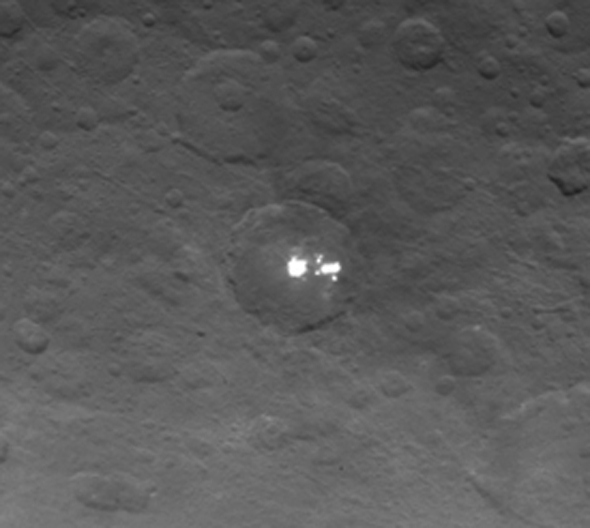The Bright Spots of Ceres Spin Into View
New images of the largest asteroid Ceres taken by the Dawn spacecraft show that one of the mysterious bright spots is actually a cluster of smaller spots.
The image above shows the spots. Dawn was just under 14,000 kilometers from Ceres when it took this shot, and the resolution is 1.3 kilometers per pixel (in the original image; I zoomed it a bit to show the spots better here). It’s hard to say exactly what the structure of these things is; they may be a couple of big spots with lots of little ones, or they could be closely packed small bright areas. The bigger one is clearly ragged around the edges, so there’s certainly more structure to be seen on smaller scales here.
We still don’t know what they are, exactly, either. They were seen (blurred together) in a Hubble image taken in 2004, and as Dawn approached Ceres it saw them as two separate spots. They are clearly made of material far more reflective than the surrounding area on the surface, and one scientist on the Dawn team speculates they could be ice. Correction, May 11, 2015 at 19:00 UTC: My friend Joel Parker, who was part of the team that observed Ceres using Hubble, has told me that the bright spot seen in the Hubble image is not the same as the bright spots in the Dawn images, and in fact the new bright spots weren't seen by Hubble. Either they weren't there then (unlikely) or they aren't quite bright enough compared to Hubble's resolution to show them as a bright spot on the surface compared to the darker area around them.
Dawn made several observations of Ceres on May 4, and they’ve been put together into a nifty animation showing it rotating:
Photo by NASA/JPL-Caltech/UCLA/MPS/DLR/IDA
One thing I’ll note: Ceres, on the whole, is dark. It reflects about 10 percent of the sunlight that hits it. Vesta, the other asteroid visited by Dawn, reflects more than 40 percent of the sunlight hitting it. Vesta’s unusually bright, but many other asteroids have albedos (reflectivity) around the 20 percent range. Some are darker even than Ceres; Emily Lakdawalla has a great graphic comparing asteroid albedos at the Planetary Society.
The images presented here have been stretched in brightness to be able to show the darker surface of Ceres as well as the brighter spots. Dawn has an instrument on board that can map the mineral composition of the asteroid’s surface, and now that the spacecraft has settled into its science orbit, it'll circle Ceres and ping away at it, taking thousands of observations. Hopefully we'll have an answer soon.
I do love a mystery, and these spots certainly count. And even though we may find out what they’re made of, solving that part of the mystery, there's still the next fun part: Figuring out why they’re there.



